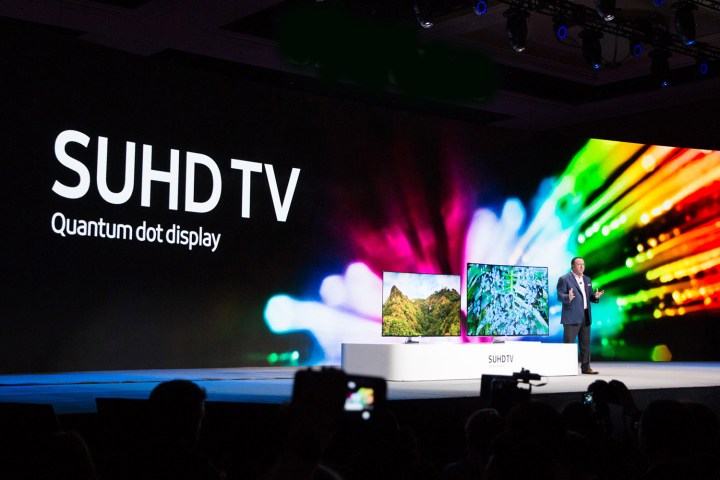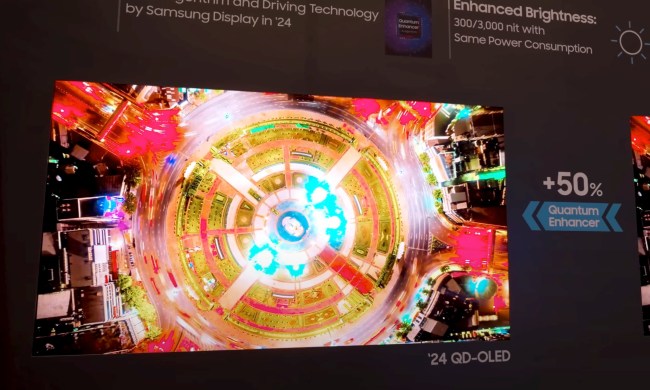

Or is it?
Samsung has an entirely new TV technology that it believes is even better than OLED, Digital Trends has exclusively learned. This fact comes as a surprise after several years of speculation over Samsung’s dormancy in the OLED space. Despite showing OLED panels as recently as 2013, Samsung currently sells no OLED televisions. Now, the company claims it is poised to aggressively pursue a new type of self-emitting TV display panel that it claims is emissive, just like OLED and plasma. And it will do it using quantum dots.
Quantum what?
If you’ve payed much attention to the development of 4K UHD TVs with HDR, you may have noticed the mention of quantum dots. You’ll see the term “quantum dots” splattered all over Samsung’s premium TV packaging, in its TV commercials, and on posters hung in electronics stores. But quantum dots are much more than a marketing ploy. The incredibly advanced technology, developed in this case by Nanosys, has significantly improved the Samsung LED/LCD TVs we know today.
Quantum dots are about to take on a new role, Nanosys CEO Jason Hartlove told Digital Trends at the IFA 2016 tradeshow, after revolutionizing LCD TV technology. And it may put OLED TV squarely in Samsung’s cross-hairs.
To appreciate how Samsung’s promising new TV tech will work, however, we first need a primer on how quantum dots currently work in Samsung’s TV lineup.
Fixing the LED problem
In a very simplified nutshell, conventional LCD televisions pass light from an LED backlight through a series of color filters to create the images you see from your couch. To get the most accurate color, these color filters need to start with perfect white light, and herein lies the problem: LEDs can’t produce pure white light. The closest they can get is yellow. As a result, the color filters have to work extra hard to block out everything but the red, green, and blue wavelengths needed to mix all the different colors in the visible spectrum. In the process, a lot of light energy is lost, and the resulting colors still aren’t very accurate — you get dim versions of imperfect red, green, and blue, and, therefore, relatively inaccurate color. That’s where the dots come in.
The new design replaces red, green and blue color filters with segregated stacks of quantum dots.
Quantum dots are tiny particles that glow when you shine light on them. By changing the size of these tiny particles, you can get them to glow any color you want, and if you mix them right, they’ll glow a perfect white light. Current Samsung TVs use a sheet of quantum dots that glows perfectly white when a certain shade of blue LED light is shone on it. The color filters love this because carving out the red, green, and blue the TV needs is a much easier and much more efficient job. The result is a much brighter, more vibrant picture with more accurate color.
The only problem with this approach is that LCD panels can’t completely prevent all of that white light coming from behind it from escaping; it’s especially apparent when the screen is supposed to be dark, or worse, totally black. That’s where the light bleed and halo issues reviewers are always complaining about come from. But Samsung’s new use of quantum dots promises to fix all of that, resulting in a picture that could come very close to OLED in terms of black levels, and could even blast it out of the water in terms of color accuracy and brightness. Oh, and it should come cheaper, and sooner as well. Here’s how it will work.
Same dots, different display
Samsung’s new TV concept ditches color filters entirely — after all, that’s where all the light energy is lost. Plus, it requires that you pass the backlight through a long “tunnel” of sorts before it gets to the viewer’s eyes, which results in poor off-angle viewing. But if Samsung ditches the color filter, where does the color come from? Quantum dots, naturally.
The new design replaces red, green and blue color filters with segregated stacks of quantum dots, which shine pure red, green and blue when exposed to a blue LED backlight. The colors you see are no longer filtered, they’re directly emitted, similar to an OLED or plasma display. A conventional LCD panel must still act as a grid of shutters behind these quantum dots to selectively block light from reaching them — that’s how we get blacks.
Once the production process is dialed in, these TVs should be relatively inexpensive to make.
That being the case, pixels cannot be individually switched off — a property of OLED panels that produces their outstanding black levels. But Samsung says there’s still an advantage: Because quantum dots are activated to glow by blue LED lights instead of yellowish-white ones, any “leaking” light will be toward the outer edge of the visible spectrum, which humans are less perceptive to. Samsung claims that should cut down on the nasty “halo” and “light blooming” effect that TV reviewers love to hate.
The end result should be a TV with an exceptionally bright, vibrant picture, excellent color accuracy, much improved black levels, and superior shadow detail. While it may not reach OLED’s true-black black levels, Samsung claims it should come extremely close, and once the production process is dialed in, these TVs should be relatively inexpensive to make — certainly much less expensive than OLED.
OLED has yet to transform the TV market, but every expectation had been for it to do so. Will this new technology from Samsung and Nanosys change everything? Only time — and our eyeballs — will know for sure.



